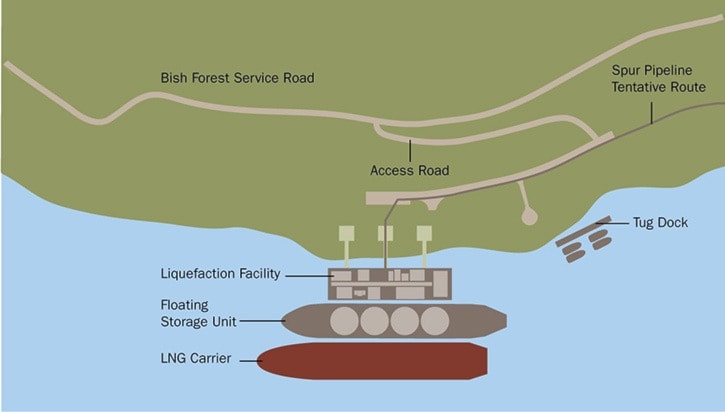THE next step toward a small liquefied natural gas (LNG) project being planned near Kitimat should be known within days.
That's because Pacific Northern Gas (PNG), which would supply the natural gas to the Douglas Channel LNG project, has to tell the B.C. Utilities Commission whether it wants to build a 10-inch line just for the project or a larger 30-inch line sufficient for that project and for other potential ones in the same area.
The company will file to the utilities commission by Jan. 29, building off of approval given last November for PNG to build either line.
The approval for either line, both of which would be approximately 9km in length from the current end of PNG's natural gas line in Kitimat, is part of a series of complex moves involving PNG's parent company, AltaGas of Calgary.
AltaGas is a partner with Japanese energy giant Idemitsu Kosan and with international energy trader EDF Trading and Belgium-based energy shipper and provider EXMAR in Douglas Channel LNG.
In turn, AltaGas and Idemitsu Canada are partners in a second potential LNG project known as Triton and going ahead of this one would require the larger 30-inch line.
That line would also be sufficient to supply a third potential LNG project, Cedar, which is backed by the Haisla Nation.
All three LNG projects would have gas-cooling plants housed on floating barges and the Haisla would benefit from both Douglas Channel and Triton in addition to Cedar.
If PNG tells the utilities commission it wants to build the larger 30-inch line it would need to build what would be a companion natural gas line to its existing 10-inch line stretching west of Prince George which now serves customers in the northwest to supply the LNG projects.
It's commonly known as the “looping project” and PNG has already filed a project description with provincial environmental regulators in preparation for eventual construction approval.
Neither PNG nor parent AltaGas have signalled their intentions leading up to the Jan. 29 filing deadline date and the utilities commission has said it has yet to hear from PNG.
“There's still really nothing to say,” said AltaGas official Sandra Semple this week.
At a planned export volume of up to 550,000 tonnes of LNG annually, Douglas Channel LNG would be the smallest of the nearly 20 LNG projects under consideration along B.C.'s coast.
Its beginnings go back to the last decade when companies no longer involved began promoting the idea of a small LNG plant.
The project slid into financial troubles, resulting in AltaGas and its partners stepping in two years ago during bankruptcy proceedings.
That, combined with the AltaGas purchase of PNG in 2011, gave the Calgary company the means and opportunity to move the project forward.
At the time AltaGas officials said they had what no other prospective LNG developer has in the northwest – an already-constructed natural gas pipeline.
Aside from the economic impact of the project to the region, northwestern residential and other natural gas users stand to gain another benefit from Douglas Channel LNG.
For more than a decade PNG's northwestern natural gas customers have been paying among the highest rates in the province for the commodity.
That's because as large-scale users of natural gas such as pulp mills began to close, remaining customers began to shoulder more of the cost burden of maintaining PNG's existing 10-inch line.
With Douglas Channel LNG to take up the majority of the capacity of the line, its payments to PNG would then result in a reduction of transport costs to its existing customers.
The development of the renewed Douglas Channel LNG partnership, however, has not been without difficulties.
Last year federal customs officials said they'd impose a customs duty on the project's floating LNG barge which would be built in Asia and towed to the Douglas Channel area.
That duty charge amounting to $100 million stems from federal regulations designed to encourage domestic shipbuilding instead of importing vessels.
AltaGas officials have argued that the floating facility is not a ship and have appealed the duty decision which would add to the planned $600 million cost of the project.
AltaGas is still waiting to hear the result of its appeal which was originally expected to be released late last year.
“We've heard nothing yet,” said company official Semple.
Another federal body, the National Energy Board, did have good news for the project last week by granting it a 25-year export licence.
